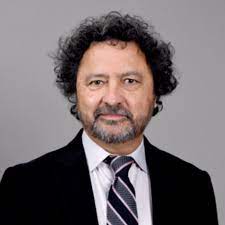
"Photo-induced, Spin-polarized Electron Transfer in Chiral Molecules"
Electron transfer (ET) reactions are ubiquitous in chemistry and biochemistry, and in living systems they play a pivotal role in enzymatic catalysis, photosynthesis and breathing. Our understanding of ET reactions is primarily based on Marcus theory where electron spin plays a minor role. During the last decade it has become increasingly clear that the possibility of spin-polarized electron transport and transfer must be taken explicitly into account in trying to understand anomalous length and temperature dependence on ET reactions.
The onset of spin polarization in chiral molecules, which are involved in many ET reactions in biological systems, requires the inclusion of spin-orbit interaction, and is determined by a combination of the breaking of space inversion symmetry, associated with chirality, and time reversal symmetry. The latter is induced by the coupling of the molecules to the environment, which transforms them in open systems. As such spin polarization is a sort of molecular magnetic response that is present even in the absence of external magnetic fields that is associated with non-equilibrium electron transport and electron transfer. The effect is known in the literature as the Chiral-Induced Spin Selectivity (CISS), as has profound influence in the fields of spintronics, magneto resistance, chiral discrimination, and spin-dependent reactions.
In this conference, I will summarize the main results of the theory of spin-polarized ET both as a purely electronic and vibronic phenomenon in molecular junctions and spin-dependent reactions, and also its consequences in photo-induced chemical processes.
Acknowledgements: V.M acknowledges the support of the W. M. Keck Foundation through the grant Chirality, Spin Coherence and Entanglement in Quantum Biology.
References:
[1] Clarice D. Aiello, John M. Abendroth, Muneer Abbas, Andrei Afanasev, Shivang Agarwal, Amartya S. Banerjee, David N. Beratan, Jason N. Belling, Bertrand Berche, Antia Botana, Justin R. Caram, Giuseppe Luca Celardo, Gianaurelio Cuniberti, Aitzol Garcia-Etxarri, Arezoo Dianat, Ismael Diez-Perez, Yuqi Guo, Rafael Gutierrez, Carmen Herrmann, Joshua Hihath, Suneet Kale, Philip Kurian, Ying-Cheng Lai, Tianhan Liu, Alexander Lopez, Ernesto Medina, Vladimiro Mujica, Ron Naaman, Mohammadreza Noormandipour, Julio L. Palma, Yossi Paltiel, William Petuskey, João Carlos Ribeiro-Silva, Juan José Saenz, Elton J. G. Santos, Maria Solyanik-Gorgone, Volker J. Sorger, Dominik M. Stemer, Jesus M. Ugalde, Ana Valdes-Curiel, Solmar Varela, David H. Waldeck, Michael R. Wasielewski, Paul S. Weiss, Helmut Zacharias, and Qing Hua Wang. A Chirality-Based Quantum Leap, ACS Nano 2022 16 (4), 4989-5035 DOI: 10.1021/acsnano.1c01347
[2] Albert C Aragonès, Ernesto Medina, Miriam Ferrer‐Huerta, Nuria Gimeno, Meritxell Teixidó, Julio L Palma, Nongjian Tao, Jesus M Ugalde, Ernest Giralt, Ismael Díez‐Pérez, Vladimiro Mujica
“Measuring the Spin Polarization Power of a Single Chiral Molecule”
Small 13(2017)1602519.
[3] Aragonès AC, Aravena D, Ugalde JM, Medina E, Gutierrez R, Ruiz E, Mujica V, Díez-Pérez I. Magnetoresistive single-molecule junctions: The role of the spinterface and the CISS effect. Isr J Chem [Internet]. 2022;62(11-12)
